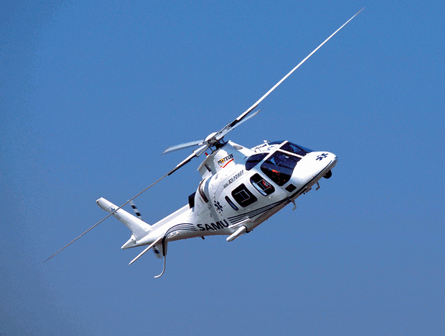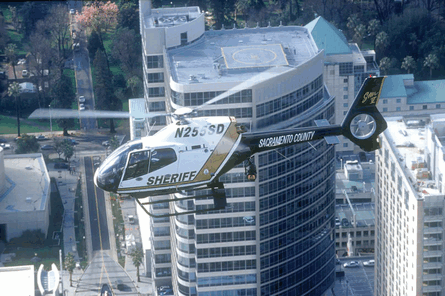There is a fresh impetus when it comes to green issues among Europe’s helicopter community. The drive for improved environmental performance is nothing new, but the launch of the wide-ranging European Clean Sky programme in February has crystallised efforts.
Clean Sky is unique in that it cuts across the whole aerospace industry, aiming to give Europe a competitive edge in introducing green aircraft technologies over the next seven years. And it is backed by big money – €1.6 billion ($2.5bn) of funding shared between the public and private purse.
The Green Rotorcraft Platform makes up one of six research areas or ITDs (Integrated Technology Demonstrators). The core aims are to lower greenhouse gas emissions through reduced fuel consumption, lessen the noise impact of helicopters and to improve environmental performance throughout an aircraft’s service life.
The research extends to both helicopters and tiltrotors and will involve preliminary studies to determine technologies that can later be tested on a larger scale. AgustaWestland and Eurocopter are taking joint leadership of the rotorcraft ITD along with a myriad of smaller partners.
 |
|---|
“The value of helicopters in the commercial market is direct flight,” says Eurocopter’s Dominique Orbec, “and that means getting people where they need to go quickly, particularly in urban environments. For helicopters to prosper in the future they need to be able to operate in an environmentally friendly way and that is what Clean Sky is all about.”
The studies will look at innovative rotor blade technologies, lower airframe drag, the possible integration of diesel engine technology and advanced electrical systems to eliminate noxious hydraulic fluids and reduce fuel consumption.
A Eurocopter EC120 will be modified to be powered by an advanced diesel engine. The goal will be a 30% reduction in fuel consumption, a 40% cut in CO2emissions and a 53% cut in oxides of nitrogen (NOx) emissions.
Further work will focus on the optimisation of a turboshaft engine to minimise power loss. Again there are challenging targets – a 10% cut in fuel consumption, 26% reduction in CO2 emissions and 65% reduction in NOx emissions.
AgustaWestland is taking a lead role in reducing external helicopter noise – one of the main areas of study within the Green Rotorcraft platform. “We are studying a number of options to reduce the overall acoustic signature of the helicopter, particularly in relation to the blades,” says Giuseppe Pagnano from AgustaWestland’s Research and Development team.
“Active blade control is one area. If successful we will conduct ground testing of an active blade segment, downscaled wind tunnel modelling and eventually fly with an optimised rotor. By 2020 the goal is to halve the level of perceived noise from the helicopter.”
AgustaWestland is also leading investigations into how to create more environmentally friendly flight paths to improve ‘green’ performance. “This will involve advanced noise abatement procedures for take-off and landing,” explains Giuseppe. “What we are aiming for is to give helicopter pilots information in real-time on their instrument displays so that they can select the most effective approach to fly. This would not only produce quieter operations, but also reduced fuel consumption.”
European collaborations in the environmental rotorcraft field do have precedents. The OPTIMAL and Friendcopter programmes have been in existence since 2004. OPTIMAL studied how to improve capacity in the air traffic system in order to better integrate helicopter operations.
Dominque Orbec explains: “Airspace is becoming saturated, particularly close to airports. OPTIMAL looked at the issues for helicopters and how to develop specific ways of handling fixed and rotary wing traffic with different approach paths. From an environmental standpoint, the more direct the approach, the greater the benefits.”
Noise pollution has long been the enemy of helicopter operators and this was the key focus of Friendcopter – a Europe-wide collaboration of 30-plus partners which was a pre-cursor to Clean Sky. The research looked at how to reduce aerodynamic noise via the development of active noise control systems for main rotors. It also investigated reductions in engine noise through better engine integration and changes to the shape, position and design of tailpipes and air intakes.
 |
|---|
Targets for noise reduction under the programme include plans to reduce the acoustic footprint areas by up to 50% depending on the flight regime and reducing cabin noise below 75dBA, similar to commercial airliner cabins in normal cruise flight. Cabin vibration would also be below 0.05g.
A major flight test campaign was conducted in 2007 to test quieter flight procedures. Using a Eurocopter EC130, the campaign included procedures for take-off, approach and cruise and earned the industry team recognition in the shape of the Cheeseman prize for best helicopter-related technical publication at the European Rotorcraft Forum in Kazan, Russia.
Orbec adds: “Similar tests are now being carried out with an EC135, supported by a software tool called HELENA (Helicopter Environmental Noise Analysis). This is a predictive tool that can show noise footprints and will help to give authorities the information they need to develop procedures for all types of helicopter.”
Source: Flight International
















